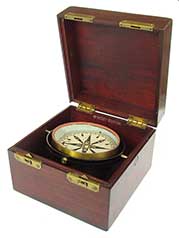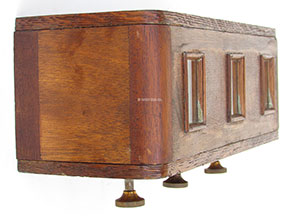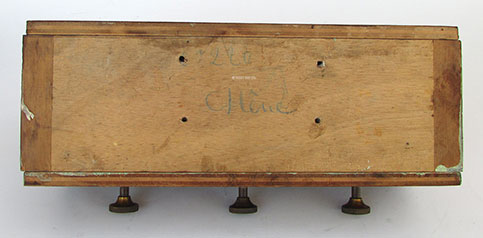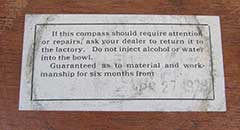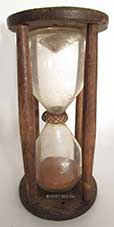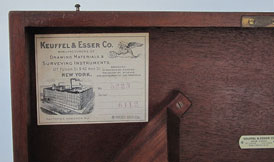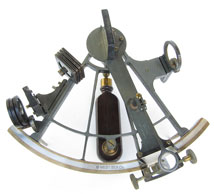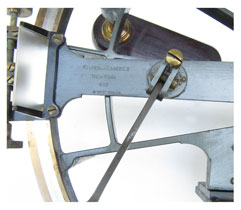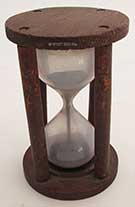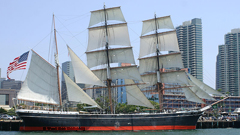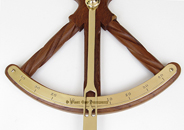West
Sea Company
NAUTICAL
INSTRUMENTS
Catalog Page 3

When no price is shown, use  button to request the price.
button to request the price.
Click on photos for larger images.
Click
 for ordering details.
for ordering details.
|
3.27 SHIP’s
INCLINOMETER. Scarce, very high quality all
brass ship’s pilothouse inclinometer of German
manufacture. This precision instrument features a
white enamel dial prominently marked “CLINOMETER , Oil
Damping.” while at the bottom it bears the logo “GEHNA
Made In Germany.” The dial is protected by a
convex glass crystal which is
perfect. This genuine ship’s instrument is
in virtually pristine original condition and operates as
designed. It measures 6 1/8 inches in diameter.
A very nice, functional instrument for the money. Try
to buy one new at this price!
169
|

|
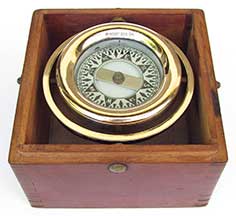
|
|
3.35 EARLY SHIP’s WATCH
GLASS. Very rare, first half of the 19th
century genuine sailing ship’s sand timer of
½ hour duration made even rarer by the fact that
it still retains its original maker’s label! The
green shield-shaped label is signed in fancy script “W.
LOWE, Optician & SPECTACLE MAKER, 18 Upper
Islington, LONDON, NW.” This classic watch
timer has disc ends made of oak inscribed with concentric
lines and decoratively-turned oak columns. The single
piece hand-blown glass flask has two bulbs containing
orange-brown sand. Indicative of its early
manufacture, the bulb on the opposite end has a small
cloth-covered plug through which the sand was originally
introduced. The glass is encircled by concentric
layers of thin oak veneer, which serve to protect and
strengthen the bulbs on each end. 6 inches high and 3
¼ inches in diameter. The condition is
outstanding and original with nice old surfaces. The
sand flows smoothly without interruption and the timer is
surprisingly accurate. 795
Gloria Clifton, in “Dictionary of British Scientific
Instrument Makers 1550 – 1851,” 1995, Philip
Wilson Publishers, Ltd. London, lists Lowe as an optician
and spectacle maker in London from 1835 – 1842.
He is also noted as having been a “Philosophical and
Mathematical Instrument Maker” in addition to being an
optician, verifying the fact that he did in fact manufacture
other instruments such as this navigational timer.
The exact origins of sand timers are unclear, although they
are generally attributed to the Arab world. From
ancient times the passage of water was used as a measurement
of time in "water clocks." As a follow-on, the "fluid
dynamics" of flowing sand was seen to be similar. "By the
Middle Ages the sand-glass came into its own and, fragile
though it was, this was the first clock which the men who
made the great voyages of discovery took with them."
(Jean Randier, "Nautical Antiques for the Collector,
1977, Doubleday & Co., New York, page 96). "Dating
old sand glasses can be difficult, but the color or tint of
the bulbs is a help. The glass was greenish up to
about 1700. During the 18th century it was darker;
then in the 19th century it gradually acquired the
transparency of crystal. There were also variations in
the actual sand which, prior to about 1720, was reddish or
orange-red in color. After about 1720, white or green
sand was increasingly used." (Alan Major, "Marine
Antiques," 1981, A.S. Barnes & Co., New York, pages
178-179.)
In the early days of sail ship's personnel stood watch on
deck for a period of 4 hours marked by 8 half hour
intervals. Before the advent of reliable mechanical
timekeepers, it was the duty of the boatswain mate of the
watch or the helmsman to monitor the ship's "watch glass"
and announce each of its half hour passages with a
successive stroke of the helm bell, one through 8. To
this day "ship's bell" clocks mimic this ancient seafaring
tradition.
|

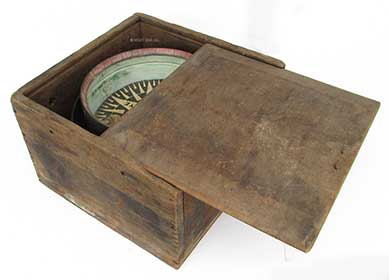
|
|
3.32 EARLY AMERICAN
COMPASS. Virtually pristine early
American hand-held compass made by the legendary American
makers “S (Samuel) Thaxter & Son, Boston,”
as signed around the pivot of the card. The
beautifully-engraved paper card is marked down to 1/2 points
with the cardinal and intercardinal points identified and
North designated by a classic fleur-de-lis. The body
of the compass is solid brass along with its original
press-fit cover. The diameter is 3 ½ inches and
it is just over 1 ½ inches thick. Unbelievably
superb original condition for being over 150 years
old!
449
Samuel Thaxter was born in 1769. In 1792 he began business
as a nautical instrument maker and chandler at 1 Long Wharf,
Boston. In 1822 he took his son, Joseph H., into the
business and it became Samuel Thaxter & Son. The
business continued under that name well into the 20th
century under a number of successive proprietors.
However the early form of this dry card compass and the fact
that it is only marked in points and not degrees, indicates
an early origin. Accordingly, it easily dates prior to
1850.
|

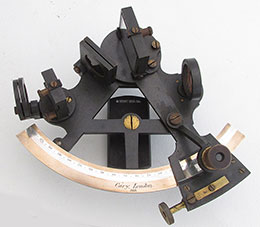
|
|
3.38 MARINER’s SEXTANT.
Finest quality late 19th century English
navigational sextant attributed to Heath & Company,
London. This Class “A” instrument features
an all brass lattice frame in its original blackened
oxidized finish. The inlaid silver scale on the large
arc reads from -5 to 155 degrees effectively making it
a quintant. The precisely calibrated scale indicates
single degrees, marked in 10’s, divided down to
10 arc minutes. The silver vernier on the index arm,
reading right to left 0 – 10 allows for a reading down
to 10 arc seconds. This is accomplished by a positive
knurled thumb screw stop and a knurled fine adjust
knob. To aid in taking the reading a high quality
pivoting magnifier with focusing feature and frosted
glass light diffuser is supplied. This sextant is
complete with both adjustable mirror boxes and a full set of
4 index filters and 3 horizon filters. A height
adjustable sight tube holder is provided, raised and lowered
by a knurled thumbscrew on the back. The back also
features 3 support “feet” for mounting in the
box and a lovely sculpted rosewood handle for holding the
instrument while taking a sighting. This instrument
comes complete in its original hand-dovetailed mahogany box
with a full compliment of attachments! They include 3
telescopes, a peep sight, a spare eye piece, 2 eyepiece sun
filters, mirror box adjusting tool and the original skeleton
key with box lock. The green felt-lined box, complete
with heavy brass carrying handle, both hook and eye closures
and inlaid shield on the lid, is in excellent original
condition. Of great historical interest and added
value is the fact that an original old label is attached to
the bottom of the box. It reads, “Cunard White
Star T Tourist Class.” The sextant itself
measures 9 ½ inches long on the index arm and 10 wide
on the large arc. The box measures 10 by 10 ¾ by
5 inches thick. The entire presentation is in a
remarkable state of original preservation. 
|
|
|
|
|
|
|
BOX
|
BOX DETAIL
|
LABEL
|
IN BOX
|

|
|
3.31 AMERICAN YACHT LOG.
Second half of the 1800’s
taffrail log made by “JOHN BLISS & CO. TAFFRAIL –
LOG – NEW YORK U.S.A.” as
marked on the porcelain register. This virtually
pristine example features a porcelain dial housed within a
cylindrical solid brass body with glazed zinc cover.
The side of the cover is cast in relief on both sides, “BLISS.
NEW YORK, U.S.A.” The register itself contains
three dials internally linked by reducing gears to the
spinner. The uppermost indicator is calibrated in
tenths of nautical miles. The middle register records
whole miles, 0 – 10, and the lower register indicates
10 of miles from 0 – 100. Accordingly, this “nautical
odometer” can record distances traveled through the
water from one tenth of a mile to more than 110 miles.
This is accomplished by the taffrail spinner otherwise known
as the “fish” which trails the log under water
and rotates by means of its curved fins as the vessel makes
way. The fish is finely balanced using small cuts in
the anterior fins, one of which is impressed “BLISS.”
A substantial pivoting brass yoke with eye is provided
for attaching the log by the cotton line to the
vessel. The entire presentation is in a
remarkable state of restored preservation, functional, with
bright brass surfaces. The log itself measures 10
½ inches long and the spinner is 9 ½ inches long
by 4 inches wide. Included in this offering is the
original cotton line which is several fathoms long.
595
|
|
|
|
|
|
|
REGISTER
|
REGISTER DETAIL
|
MAKER
|
REVERSE
|


|
|
3.29 FRENCH SEXTANT. Scarce,
remarkably pristine mid-1800’s sextant with the large
arc engraved in beautiful script “Lagarde Optician a
Bourdeaux.” This lovely marine navigational
device is made entirely of brass with an inlaid silver scale
calibrated from -5 degrees to 125 degrees divided by 20 arc
minute increments. The precise vernier scale on the
index arm, divided from 0 – 20 minutes, allows for a
reading down to 30 arc seconds. To these ends a simple
pivoting magnifier is mounted on the arm to provide the
reading. The tip of the arm is equipped with a knurled
thumbscrew stop and tangent thumbscrew for fine positioning
of the sighting. This sextant is complete with it s
large index mirror, split image horizon mirror and full
compliment of 3 index shades and 2 horizon shades. The
sight tube holder has a built-in peep which cleverly pivots
out of the way to accept the single auxiliary
telescope. On the back of the flawless cast brass
frame is the classic sculpted hardwood handle for grasping
and two long brass “feet” for support in the
box. The original mahogany box is of early
hand-dovetailed construction with all brass furniture
including two hook and eye closures, original lock with
functional skeleton key, folding brass drop handle and high
quality brass hinges. The box is complete with the
single optical telescope, an eyepiece sun filter and knurled
mirror adjustment tool. Nothing is missing and nothing
is damaged! This diminutive navigational
instrument measure 8 ½ inches on the index arm and 8
inches wide on the large arc. It fits neatly into its
box which is 10 inches wide, 8 ½ inches deep and 4
½ inches thick. A more beautiful, functional
presentation is not to be found! 
|
|
|
|
|
|
|
BOX
|
IN BOX
|
SEXTANT
|
SIGNATURE
|

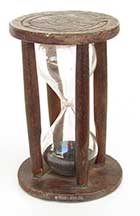
|
|
3.26 CASED OCTANT.
Fine, circa 1830’s English navigator’s octant
with limbs of ebony and scales of ivory. The
large arc is calibrated in single degrees from -4 to 104
subdivided to 20 arc minutes, effectively making it a
"quadrant." A blank ivory “maker’s plate”
is inlaid in the cross brace. The flat brass
index arm 12 inches long has a single thumb screw stop
without a fine adjust tangent screw. The ivory vernier
scale with “0” on the right allows a reading
down to a single arc minute. This octant is complete
with its single peep sight, index mirror, full set of 3
sunshades and split image horizon mirror. The
back has three turned brass “feet” for mounting
in the box. To those ends it is complete with the
original mahogany “keystone” box with brass
hinges, brass lock with inset skeleton key escutcheon and 2
hook and eye closures. The instrument measures 10
inches across the large arc. The box measures 12
½ inches long, 11 ¾ inches wide and 4 inches
thick. This octant is in a truly remarkable state of
original preservation. The scales are crisp and
bright, and all brass surfaces are clean and sharp with
absolutely no signs of cleaning or restoration. The
box too is in lovely original condition in its original
finish. There are the usual age cracks in the wood and
a couple of minor chips. But as these early instrument
go, this box rates as a 9 on a scale of 10. A fine
addition to any discriminating collection.

A number of the features of this instrument are telling of
its age. The flat brass index arm without a brace is a
trait that dates back to the 1780’s. The lack of
a fine adjust tangent screw is also a characteristic of
octants and quadrants from the 1700’s. Finally,
the fact that this instrument has a single peep sight with
no provision for optical attachments is another aspect which
harkens back to the earliest such devices.
|
|
3.23 PILOT HOUSE
INCLINOMETER. World War II vintage
merchant marine ship’s pilot house clinometer
made of Bakelite, glass and brass. It is
marked in the middle,
CLINOMETER
U.S. MARITIME COMMISSION
MK IV
1944
JOHN L. CHANEY INSTR. CO.
LAKE GENEVA, WISC. U.S.A.
PATENT DESIGN
This clever navigational device was used to
measure the ship’s heel from 0 - 70 degrees
port and starboard. To accomplish this a
glass tube filled with liquid and a weighted ball
acts much like a turn and bank indicator on a
airplane. The liquid “damps” the
travel of the ball, giving a more consistent
reading. The instrument measures 12 ½
inches wide by 6 ½ inches tall and has two
mounting holes in the face for attachment to the
bulkhead. Excellent original cosmetic
condition and fully functional.
325
|
|

|
3.21 CLINOMETER. Genuine,
mid-century ocean-going ship’s pilot house
inclinometer made of solid brass and affixed to a wooden
backboard. This handsome unit features a heavy
weighted brass pendulum bob which indicates the ship’s
degree of heel, port and starboard from 0 to 40, calibrated
in single degree increments. It is boldly marked “CLINOMETER”
in red at the top and is signed “Jin Hang Marine
Equipment Co.” across the face. 9 ½ inches
wide by 7 ¾ inches tall. Excellent original
condition showing good signs of actual use. A scarce
navigational instrument of which there are typically only
one per ship.
179
|

|

|
|
3.20 BRASS OCTANT. Scarce,
first half of the 1800’s English navigational octant
made by the noted maker (John) “Crichton, London”
as engraved on the large arc. This precision marine
instrument is made entirely of brass with an inlaid silver
scale beautifully calibrated from -5 degrees to 120 degrees
of arc in 20 arc minute increments. The maximum travel
of the index arm is limited to just 103 degrees, effectively
making this instrument a quadrant of 90 degrees –
or in more contemporary terms at that time – an “octant.”
Of handsome form, this all brass instrument has 9 ¾
inch index arm with a silver vernier scale calibrated from 0
to 20 single arc minutes, providing a very accurate reading
for such a compact instrument. To take the reading an
adjustable, pivoting magnifier is provided on the index
arm. The arm is provided with a knurled thumbscrew
stop and another fine adjust tangent knob. This
instrument is complete with both its mirrors, full set of 4
index filters and 3 horizon filters. On the back are
three brass “feet” for support in the carrying
box, and the classic sculpted rosewood handle. All of
this fits neatly into the fine mahogany box, typical of the
early 1800’s manufacture. This
classic “keystone” box is of hand-dovetailed
construction and measures 11 inches tall by 11 ¼ inches
wide and 5 ¼ inches thick. The original brass
skeleton key lock is present. The entire presentation is in
outstanding original condition. The box is complete
with all optical and peep sight attachments, along with the
mirror box adjusting tool and eyepiece filter.
The lid bears the original label of a Paris
chandler as well as the remnants of another label.
Interestingly, some original observations taken by this
sextant are penned on the label! This is a
beautiful example of an early 1800’s English
octant.
1895
John Crichton began his business as an optical,
philosophical, mathematical and nautical instrument maker at
32 Fore Street, Limehouse, London in 1831. He moved to
112 Leadenhall Street in 1834 where he remained in business
until 1865. Crichton was apprenticed to the well known
early sextant maker Benjamin Messer. Among the items
Crichton was known to produce were barometers, compasses,
sextants, telescopes, artificial horizons, microscopes and
thermometers. (Gloria Clifton, “Dictionary of British
Scientific Instrument Makers 1550-1851,” 1991, The
National Maritime Museum, London). We have had other
fine quality instruments with the “Crichton”
signature.
|

|

|
|
3.19 RARE 18th CENTURY SEXTANT BY THE
INVENTOR. Magnificent, very early English
navigational sextant of the finest quality made by “Troughton,
London” as engraved on the large arc. This
classic “double frame” sextant, also known as
the “pillar frame” was made with Troughton’s
innovative design using two thin sheets of brass held
together with turned support pillars which contributed to
its lightweight yet rigid construction. Hence the term
“pillar frame.” An unusual feature of this
particularly early instrument is the fact that the scale is
divided directly onto the large brass arc from -5 degrees to
150 degrees subdivided to 15 minutes. Later
instruments featured inlaid scales of silver, gold or even
platinum! The braced index arm has a silver vernier
calibrated from 0 to 15 arc minutes, which is subdivided to
provide a reading down to 15 arc seconds. A
pivoting magnifier is mounted on the index arm to take the
fine reading. The arm is equipped with a positive stop
and a tangential fine adjust knob. This full-size all
brass sextant has both index and horizon mirrors and its
full sets of index and horizon filters. The
height-adjustable telescope holder is controlled by a
knurled knob on the reverse. The sculpted rosewood
handle and three “feet” complete the back
side. The original hand-dovetailed “keystone”
mahogany box in black finish is of early form containing a
single telescopic sighting tube. The box has two hook
and eye closures and the original brass lock with skeleton
key. It measures 10 high by 14 inches wide and 5
inches.  
Edward Troughton was born in London in 1753. At the
age of 17 he began working with his brother, John, managing
their uncle's instrument-making firm on Surrey Street, the
Strand, London. In 1782 they set up shop at 136 Fleet
Street under the sign of "The Orrerey." Edward
was a contemporary of the famous Jesse Ramsden who was
credited with making the first commercially viable dividing
engine in 1773. In 1778 Edward made a dividing engine
himself and began his sextant manufactory. Up to that
time sextants could only be produced in very limited
quantities using the laborious hand division method.
Edward saw an opportunity to expand the navigational
instrument market and in that same year introduced his
famous "pillar frame" or "double" sextant with its scale
calibrated on his newly-made dividing engine. His
design was very similar in its concept to trusses used in
the construction of iron bridges at the time. The idea
was to fabricate a strong, rigid, yet lightweight instrument
free from the vagaries of temperature, humidity and other
environmental factors which affected the accuracy of
navigational instruments at sea. Troughton’s
instrument, so constructed, was expensive. But it
quickly gained the widespread acclaim of merchant mariners
and Naval men alike. Edward's preeminence in his field
overshadowed his brother/partner John who died in relative
obscurity. Edward went on to partner with William
Simms around 1825, forming the enduring instrument making
firm of Troughton & Simms, which lasted into the early
20th century. Edward retired in 1831 and died in
1835.
This instrument with serial number XXX* (below 500) is very
early in Troughton’s manufacture and dates to
1799. This is based on an extrapolation taken from a
table entitled "Instrument Serial Numbers 1750-1850," Fig.
18.4 in an article written by A. Stimson on marine
navigational instruments for the 1976 publication Vistas
In Astronomy. The article is titled, “The
Influence of the Royal Observatory Upon Design of 17th and
18th Century Angle Measuring Instruments At Sea.” Troughton
went on to produce more than 1500 such instruments under his
own name, the latest of which dated 1826. After that
date similar sextants continued to be produced, marked with
the partnership name of "Troughton & Simms.”
The design was so popular that many contemporary instrument
makers produced copies well into the 1830’s.
The first sextants to appear in the English market made
in the early 1750’s. They were hand-divided by
the master instrument makers such as Jeremiah Sisson (w.
1749 - 1783), John Bird (Bapt. 1709-1776) and Benjamin
Cole. A telltale feature of these 18th century
navigational instruments was that the scales which were
engraved directly onto their brass frames. Later,
inlaid scales came into vogue, made of silver, gold and even
platinum. The scale of this instrument is of the very
earliest type – on brass.
* For the privacy and security of the ultimate purchaser
the serial number of this instrument is being
withheld. The actual serial number is very sharp and
readable, but we have blurred it for purposes of the
photo.
|

|
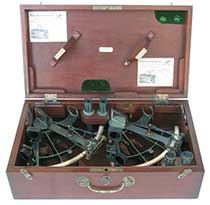
|
|
3.11 AMERICAN SEXTANT SET.
Ultimately rare, perhaps one-of-a kind, cased 19th century
double sextant set made by the prestigious
American scientific instrument company “Keuffel and
Esser, New York” as engraved on the index arms and as
indicated on their respective labels. This matched set
features not one but TWO sextants contained within their
single dovetailed mahogany box. Each sextant is made
of cast bronze with classic lattice frame design in their
original factory oxidized finish. The index arms are
signed “Keuffel & Esser Co., New York” and
are serial numbered “6101” and 6112”
respectively. The large arcs are inlaid with silver scales
reading from -5 degrees through 165 degrees, effectively
making them “quintants.” The scales are
subdivided in 20 arc minutes, with the vernier scale
allowing an accurate reading down to 30 arc seconds.
To aid in the reading each vernier is equipped with a light
diffuser on the index arm and a pivoting magnifier.
The index arm features a knurled thumbscrew stop and the
double tangent screw fine adjust feature as introduced by
the French circa 1880. Both instruments are complete
with their full set of 4 index filters, 3 horizon filters
and index and horizon mirrors. Both have their
adjustable height sight tube holders designed to accommodate
one of three (total six) sighting accessories. These
include a peep tube, short telescope and long telescope with
cross hairs. The backs of these sextants retain their
original sculpted mahogany handles and long brass “feet.”
These fine instruments are housed in their original machine
dove-tailed box with brass furniture, functional skeleton
lock and key, folding brass handle, unusual locking box
closures and inlaid “shield” escutcheon in the
lid. They are absolutely complete with all attachments
including spare mirrors, two screwdrivers, two adjusting
wrenches and 4 telescope tube eyepiece filters.
Speaking to the quality of this set, the attachment
compartments are even lined in protective green felt!
The lid of the box bears the faux ivory maker’s label
reading “KEUFFEL & ESSER CO. NEW YORK , St. Louis.
Chicago. San Francisco.” But what’s more,
each of the sextants has matching serial numbered “KEUFFEL
& ESSER Co.” labels proclaiming its manufactory,
its home office at 127 Fulton Street, with the company logo
and drawing of “Factories, Hoboken, N.J.”
Each sextant has a 7 ½ inch index arm and
measures 9 inches wide on the arc. The box measures 16
½ inches long, 9 ½ inches wide and 5 ½ inches
thick. The entire presentation is in unbelievably fine
state of preservation being in near mint, factory original
condition in every respect! Circa 1885. Truly a
rare find!
4900
The prestigious instrument making firm of Keuffel
& Esser was founded in 1867 at 79 Nassau Street,
New York City by German immigrants Wilhelm Keuffel and
Hermann Esser. In 1878 the firm moved to 127 Fulton Street
and was incorporated in 1889. The lack of "Inc." on the
trade labels here indicates these sextants were made prior
to the firm being incorporated, and date circa 1885. The
griffin trade mark begain in 1871, replaced by "Paragon" in
1901. (M.V. Brewington, "The Peabody Museum Colleciton of
Navigating INstruemtn," 1963, Peabody Museum, Salem,
Massachusetts.)
|

|
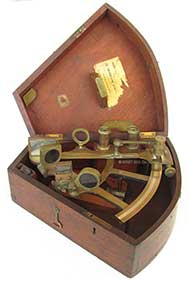
|
|
3.98 EARLY COMPASS BY THE
INVENTOR. Important 3rd quarter of the 19th
century American navigational compass by the noted inventor
and maker of the first liquid filled compass, “E. S.
RITCHIE BOSTON,” as impressed on the compass
ring. It is marked in 3 more places, “PATENTED
SEPT 9, 1862,” serial numbered “8467,”
with additional patent dates of “APL 7, 1863,”
and “MAY 18, 1868.” The unique early “doughnut”
card is constructed of brass bisected by a tubular float
signed in Ritchie’s own hand “RITCHIE BOSTON”
with a fleur-de-lis at North and “S” for
South. The other cardinal and intercardinal points are
indicated and the rose is further divided down to quarter
points of the compass (2 ¾ degrees each). The
interior is in its original thick white lead paint.
The body of this heavy compass is solid brass, weighted on
the bottom to gimbal properly – which it does in its
original brass gimbal ring. As expected after 140
years the compass is dry. We deem it best to leave
this rare compass it in its original state rather than
trying to “restore” it with modern sealants and
liquids. Remarkably the compass is still lively
and accurate. It measures 7 inches across the compass
body and 9 inches tip to tip on the gimbal ring
nibs. Unquestionably a genuine museum-quality relic at
a very reasonable price!
995
Edward Samuel Ritchie was born in 1814. In 1839 he
established a hardware business in Boston, Massachusetts
with a partner forming the firm of Palmer & Ritchie.
From 1842-1849 he ran a nautical chandlery in New Bedford.
In1850 Ritchie began his scientific instrument making career
with Nathan Chamberlain as a partner. By 1862 the company
was known as Edward S. Ritchie & Co. and in 1867 the
firm name became E.S. Ritchie & Sons.
Ritchie is credited with inventing the first practical
liquid-filled compass circa 1860. He produced a compass for
the famed Civil War iron clad USS MONITOR in 1861
and was awarded his first patent for the invention on
September 9, 1862 -- at the height of the war! A number of
improvements and subsequent patents followed. The elder
Ritchie died in 1895, but his sons carried on the business,
which still survives today as E. S. Ritchie & Sons, Inc.
Pembroke, Massachusetts.
|

|
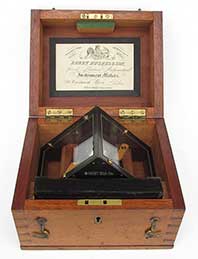
|
|
3.33 TELLTALE COMPASS. Rare, totally
original first half of the 19th century sailing ship
captain's cabin compass. This exceptional example is all
brass with the engraved paper card signed around the center
"John Campbell, 7 South Castle Street, Liverpool." The North
point is designated by a fancy fleur-de-lis with the
cardinal and intercardinal points identified. The pivot has
an agate cap and the card is divided to 1/4 points of the
compass with single degrees on the periphery. The all brass
glazed housing is slung in its original gimbal which is
suspended in a magnificent cast brass mounting bracket with
floral designs! In use, this compass would have hung from
the overhead in the captain's quarters allowing him to
monitor the ship's heading from his bunk or desk -- hence
the name "tell tale." Outstanding original condition with a
fine, rich patina. Definitely the finest example of its type
we have ever seen. The compass card is 6 1/4 inches in
diameter. The compass housing is 7 1/2 inches in diameter.
The overall width of this presentation is 10 inches.
2495
John Campbell was listed as a chronometer and nautical
instrument maker at 17 Warren Street in Liverpool from 1845
- 1855. (Gloria Clifton, "Dictionary of British Scientific
Instruments Makers 1550-1851".)
|
|
|
|
|
|
COMPASSCARD
|
CAPTAINS VIEW
|
SIDE
|
3.76 SAILING SHIP INCLINOMETER.
Very handsome solid teak and brass shipboard clinometer faithfully
copied after the original adorning the officers’ dining room
aboard the famous sailing ship the STAR of INDIA. This
high quality instrument is made from solid teak and brass with two “rope
twist” limbs and an arc covered by a brass scale divided in 10’s
from 0 - 40 degrees port and starboard. The heavy cast brass
pendulum has a decorative fleur-de-lis at the top and a unique
cut-out arrow which points to the individual degree of heel or
list. When rotated, the brass pivot knob at the apex serves the
dual purpose of locking the pendulum when not in use. The
screws holding the brass scale on either side also function as the
attachments to the bulkhead. This fine inclinometer
measures 10 ½ inches wide by 8 ½ inches tall on the
frame. The brass pendulum measures 11 inches long.
Complete with an etched brass presentation plaque reading:
.FROM THE ORIGINAL.
3-MASTED BARK
“STAR of INDIA”
_ . _
FORMERLY
“EUTERPE” 1863
In pristine condition, this inclinometer is itself over ¼
century old, having been manufactured in 1983 to commemorate the
120th anniversary of the ship.
79
The 3-masted bark STAR of INDIA is the oldest ship in the
world which still sails! She was built at the Ramsey Shipyard, Isle
of Man, England in 1863. With an iron hull, she was
state-of-the-art at the time, when most vessels were still being
built of wood. She was launched as a full-rigged ship,
christened EUTURPE, after the Greek muse of music and
poetry.
EUTURPE began her career on a turbulent note. During her
first trip she suffered a collision and a mutiny. On her second trip
she was caught by a cyclone in the Bay of Bengal. With her
topmasts cut away she barely made port. Shortly thereafter her
captain died on board and was buried at sea.
After these ill-fated beginnings, EUTERPE made four
more voyages to India as a cargo ship. In 1871 she was purchased by
the Shaw Savill Line, London and embarked on a quarter century of
hauling emigrants to New Zealand, Australia, California and Chile. In
this capacity she circumnavigated the globe 21 times with many
voyages lasting up to a year!
In 1897 EUTERPE was sold to Hawaiian interests, then
again to the Pacific Coloional Ship Company of San Francisco in
1899. In that service she made 4 voyages between the Pacific
Northwest, Australia and Hawaii carrying lumber, coal and sugar.
In 1901, EUTERPE was sold to the Alaska Packers’
Association of San Francisco and re-rigged as a bark. In
1902 the newly overhauled vessel began the final episode of her
active career carrying fishermen, cannery workers, coal and canning
supplies from Oakland, California to Nushagak, Alaska. Each
fall she returned with a catch of canned salmon. In 1906,
she was renamed the STAR of INDIA in keeping with the names
of her sister ships in the Packers’ fleet. Finally
in 1923 she was laid up after 22 Alaskan voyages, having outlived her
usefulness in the age of steam.
In 1926 the STAR of INDIA was sold to the San Diego
Zoological Society with the idea of featuring her as the centerpiece
of a museum and aquarium. To this day, she continues to fulfill
that role as the prime attraction of the San Diego Maritime
Museum.
SHIP SPECIFICATIONS:
Hull Length 212 feet
Sparred Length 280 feet
Beam 25 feet
Draft 21 ½ feet
Gross Tonnage 1318 tons

3.34 AMERICAN WOOD BOWL COMPASS.
Genuine, early 2nd quarter of the 19th century American compass
made by the noted compass maker "Robert Merrill, New York." as signed
around the central pivot. The nicely engraved dry card is divided to
1/2 points of the compass, with the cardinal and intercardinal points
identified and North marked by an elaborate fleur-de-lis. The central
brass pivot has an agate cap. Indicative of its early origin this
compass has a decorated East point, a traditional holdover in early
compass making since the Crusaders traveled East during the Middle
Ages. Even more remarkable, the compass housing is of turned
wood! The compass card measures 6 inches in diameter
and is housed in its original green-painted bowl with glazed cover
slung in gimbals within the hand-dovetailed pine box measuring 10
inches square and 7 inches high. It appears that the box originally
had a hinged lid. Overall condition is excellent. The compass is
functional and it gimbals properly. A very nice example of a scarce
American wooden bowl compass by the most famous American compass
maker of the 19th century. Given the wooden bowl construction and the
decorated East point on the card, this compass most certainly dates
from the beginning of Merrill's career, circa 1835.
995
Robert Merrill was born in Newburyport,
Massachusetts on April 19, 1804. He was first listed as a
"mathematical instrument" maker in the New York City directory of
1835-1836 with a partner, William Davis. Shortly thereafter, in 1838
Merrill struck out on his own as a compass maker at the address 141
Maiden Lane. In 1865 Merrill took his sons into the business. He died
in 1876. (Charles Smart, "The Makers of Surveying Instruments in
America Since 1700," 1962, Regal Art Press, New York.)
© 1998-2014 West Sea Co. All
rights reserved.
![]() for ordering details.
for ordering details.